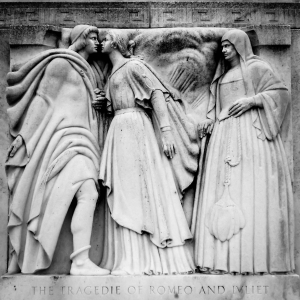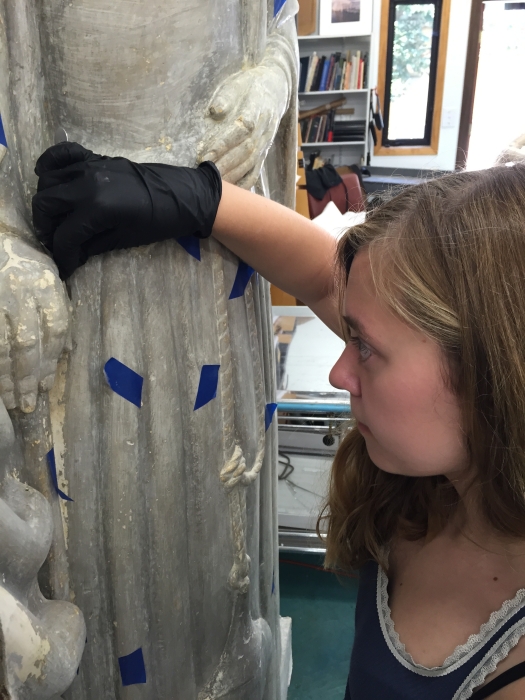While most students leave Scripps during the summer months, a few remain, lured by the appeal of a paid summer internship. One of these students is Madeline Helland ’18, who is working as a Wilson Conservation Intern this summer. The Wilson Internship is one of many paid internships offered through the Ruth Chandler Williamson Gallery at Scripps College, and this summer marks the twenty-third consecutive year that paid summer internships have been available to students.
A Claremont local, Helland had visited the Williamson Gallery periodically throughout high school and, since starting at Scripps, knew she wanted to apply to be a Wilson Conservation Intern. After taking an art history class on Dada and Surrealism with Professor Mary MacNaughton, Helland developed a specific interest in the art conservation major.
“She encouraged me to apply for the internship based on that interest, which was what ultimately inspired me to do so,” says Helland.
Helland has a busy schedule, working from 8 a.m. to 5 p.m., Monday through Friday. About three days a week, she works in the gallery’s offices. While on-site at the gallery, Helland has completed a variety of projects, including reorganizing the Asian textile storage, writing essays for the Williamson Gallery website, and cleaning sculptures on campus.
However, the other two days of the week, Helland is able to access an opportunity most first-years looking to do genuine art conservation work could only dream of. Together with a Getty Conservation Intern, Jocelyn Lo of Occidental College, Helland travels to Los Angeles to visit conservator Donna Williams’ studio in Hollywood to work on restoration of Scripps’ Romeo and Juliet Shakespeare relief by John Gregory, which usually rests outside of Balch Hall. This is the second relief to be cleaned; the first was A Midsummer Night’s Dream, now reinstalled next to the Treasurer’s Office in Balch Courtyard.
“Going to Donna Williams’ studio twice a week has been an amazing experience. It is really valuable to get hands-on experience with conserving a piece of art,” says Helland.
The Shakespeare reliefs were cut in half when shipped to Scripps in 1960, and then reassembled in Balch Courtyard. “Over the years, the panels have shown signs of separating and have had several layers of paint applied to them. The conservators have carefully removed all of the paint and taken [each relief] back down to its original surface,” explains Kirk Delman, who, as collection manager of the Williamson Gallery oversees the handling of the reliefs during the off-site removal process as well as the reinstallation of each panel to their original locations.
For further support, a stainless steel base will hold the conserved panels together, once reinstalled. Removing the paint and repairing the fragile plaster is a tedious process that can take anywhere between 12 to 18 months for a single panel. Helland and Lo are continuing detailed work on the relief from where past interns have left off, removing layers of shellac and house paint that are obscuring and damaging the surface of the plaster.
“I think my favorite part of working on the relief has been the ability to spend time in Donna’s studio. The experience of cleaning up the relief has been great, but being able to see how a professional conservator operates her business has been especially interesting,” says Helland.
Donna Williams and her husband usually work full time in the studio, which means that Helland has the unique opportunity to experience the behind-the-scenes of a professional art conservator’s work beyond the Shakespeare relief she and Lo are working on.
“Both of them are always more than willing to talk to us about another piece they’re working on that is lying around the studio and explain what happened to it and how they plan to fix it. There is a lot to learn from just visiting someone’s workplace and seeing what they do on a daily basis.”
Interns at the Williamson Gallery additionally have the rare opportunity to meet with professionals to learn about their careers in the art world, either on-site at Scripps or at museums or studios.
“This internship is especially great because it has been designed to teach us about careers in the art world and to help us develop practical skills,” Helland enthuses.
Helland plans to apply the insights she has gained about different professions in the art world, once she decides what path she would like to take post-Scripps. Delman also emphasizes the post-graduate benefits for students gaining hands-on experience through the internship program, remarking, “The hours spent on this project and working with other conservation professionals provides them greater opportunities when applying to graduate programs.”
What should Scripps students interested in pursuing a summer internship do to follow in Helland’s footsteps?
“Make sure you talk to a professor or other faculty member that is connected to a field you’re interested in–even if they don’t have a specific opportunity for you, they might be able to tell you where to start looking,” Helland advises.
For those specifically interested in working as a Wilson Conservation Intern, Helland recommends expressing interest to gallery staff and applying.
“This has been an amazing internship, so if you’re remotely interested in working in the arts it is definitely worthwhile.”
For more information about internship opportunities at the Ruth Chandler Williamson Gallery, see http://rcwg.scrippscollege.edu/internships.

